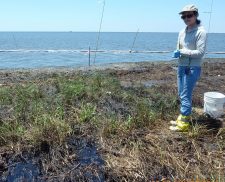Study Examines Transformation of Weathered Oil in Saltmarsh Sediment
– JANUARY 31, 2017
Scientists analyzed weathered and fresh Macondo oil to learn about oil products resulting from microbial degradation and photochemical reactions. They observed that 48 months after the Deepwater Horizon spill, less than 1 percent of oil remained in marsh sediments collected from heavily-impacted sites; however, it was still 400 times greater than sites with moderate-to-no observed oiling. Photo-oxidation and biodegradation contributed to changes in weathered oil and generated persistent oxidized products that are potentially toxic to marine organisms and environment. The researchers published their findings in Environmental Science & Technology: 4 years after the Deepwater Horizon Spill: Molecular transformation of Macondo Well oil in Louisiana salt marsh sediments revealed by FT-ICR mass spectrometry.
The long-term impacts of persistent petroleum and their weathered products are not well understood. This study is the first temporal characterization of Macondo well oil transformation products at the molecular level. The researchers catalogued oxidation patterns in oil samples extracted from saltmarsh sediments in heavily-oiled northern Barataria Bay using electrospray ionization (ESI) Fourier transform ion cyclotron resonance mass spectrometry (FT-ICR-MS) and comprehensive two-dimensional gas chromatography (GC×GC). They analyzed sediment collected 9 to 48 months post-spill, quantifying the biomarker C30–hopane and estimating the degree of hydrocarbon degradation.
Researchers observed the disappearance of low-molecular weight aromatic hydrocarbons within the first 9 months and detected few or almost no heavy alkanes by 48 months. No significant weathering was observed between 36 and 48 months, suggesting that the depletion of oil continued up to 36 months and then slowed down, or that the biomarker C30–hopane degraded over time. Bulk oxygen content in field samples increased 7-fold after 9 months, indicating that oxidative processes dominated oil weathering during the first months after the spill, and produced persistent oxidized transformation products.
Study author Amy McKenna explained the importance of applying advances in technology to oil spill science, “When assessing long-term impacts of an oil spill, it is critical to have techniques that are well-suited to determine if there is oil present and what it looks like.” She continued, “Oil is still lingering in the salt marshes, and it is being transformed into a very complex, poorly understood mixture that requires this advanced technique. We used advanced analytical instrumentation to watch oil compounds change molecule by molecule in a buried salt marsh four years after the Deepwater Horizon disaster.”
Data for this study are publicly available through the Gulf of Mexico Research Initiative Information & Data Cooperative (GRIIDC) at R1.x138.000:0001.
The study’s authors are Huan Chen, Aixin Hou, Yuri E. Corilo, Qianxin Lin, Jie Lu, Irving A. Mendelssohn, Rui Zhang, Ryan P. Rodgers, and Amy M. McKenna.
************
This research was made possible in part by a grant from the Gulf of Mexico Research Initiative (GoMRI) to the Deepsea to Coast Connectivity in the Eastern Gulf of Mexico (Deep-C) consortium and the Louisiana State University Department of Oceanography and Coastal Sciences for the projects Accelerating Recovery after the Deepwater Horizon Oil Spill: Response of the Plant-Microbial-Benthic Ecosystem to Mitigation Strategies Promoting Wetland Remediation and Resilience and Long-Term Impact, Recovery and Resilience: Wetland plant-microbial-benthic ecosystem responses to the Deepwater Horizon oil spill and mitigation strategies promoting sustainability. Other funding sources include the National Science Foundation Division of Materials Research (DMR-11-57490) and the State of Florida.
The Gulf of Mexico Research Initiative (GoMRI) is a 10-year independent research program established to study the effect, and the potential associated impact, of hydrocarbon releases on the environment and public health, as well as to develop improved spill mitigation, oil detection, characterization and remediation technologies. An independent and academic 20-member Research Board makes the funding and research direction decisions to ensure the intellectual quality, effectiveness and academic independence of the GoMRI research. All research data, findings and publications will be made publicly available. The program was established through a $500 million financial commitment from BP. For more information, visit https://gulfresearchinitiative.org/.
© Copyright 2010-2017 Gulf of Mexico Research Initiative (GoMRI) – All Rights Reserved. Redistribution is encouraged with acknowledgement to the Gulf of Mexico Research Initiative (GoMRI). Please credit images and/or videos as done in each article. Questions? Contact web-content editor Nilde “Maggie” Dannreuther, Northern Gulf Institute, Mississippi State University (maggied@ngi.msstate.edu).






